Working With Trees
Arborists look after trees as: Tree Surgeons, Tree Loppers, Consultants, Tree Planting Contractors, Foresters and other professions.

What They Do
Work may involve: removing dangerous, sick or damaged trees (or parts e.g. invasive root systems), controlling the size and shape of trees, tree repair (e.g. bracing, propping, cabling branches to prevent them breaking), removing or chipping prunings, accessing trees by climbing or with a travel tower, planting new trees, transplanting large trees, controlling and removing unwanted roots, controlling tree pests or diseases, or developing tree management plans.
- A tree lopper is someone who removes trees, but might not understand so much about how to grow or repair them.
- Tree workers may specialize: stump removalists provide a service to dispose of large stumps after the tree is removed. Stump removal can result in soil subsidence, so understanding all of the implications of dealing with 'left over' roots need to be understood.
- A consultant arborist may advise on the health of existing trees, the dangers they may pose, and actions that should be taken. They may also work with developers or landscape professionals to advise on tree selection, placement and may supervise work.
Where They Work
Arborists often work for an arboriculture business, tree removalist or tree surgeon. Some are employed by public instrumentalities. Some work in forestry and others in private enterprise. Many will start their careers climbing trees and move on to being a consultant or manager later in their careers or conduct tree inspections and write tree reports for councils. Others may leave arboriculture and find work in other areas of horticulture.
Opportunities
Non-climbing arboriculture assistants are employed to work ropes, lower branches to the ground and clear away branches. They may also operate a chipping machine. This type of work is less skilled than climbing, does not pay as much and may be an easier job to get when starting out in this industry.
A skilled climber is always in demand and can earn very good money however one should always consider whether this is a job you would plan to do for decades, or for a lesser period - as a stepping stone towards something else.
What is Needed
Climbing is dangerous work if you don’t know how to do it properly (and use appropriate climbing gear). Some arborists learn to climb on the job. Others learn by doing abseiling or rock climbing as a sport. Others may learn through a trade apprenticeship or specialised course.
Arborists also need to understand trees: to
identify plant pest and disease problems (particularly wood rotting
diseases) and differentiate between perhaps 100 or more of the more
commonly grown species of trees in their locality and the plant families they belong to.
A tree lopper removing trees, still needs to understand what woods are safe to climb up and what should not be climbed. Different species of trees are stronger or weaker; some are prone to break and others are not.
MORE ADVICE
Use our FREE COURSE & CAREERS ADVISORY SERVICE (click) and apply
More from ACS
Over 200 photos. Text covering Eucalyptus, Corymbia and Angophora.
View eBook
Ebook - A classic that has helped many to start up and run a successful business.
View eBook
Become a Professional horticulturist studying 2 years full time; 4 years p/t
View Course
Course - diagnose and treat tree disorders: pests, diseases, nutritional, drainage or environmental. Learn standard tree surgery practices, pruning and training and safety measures.
View Course